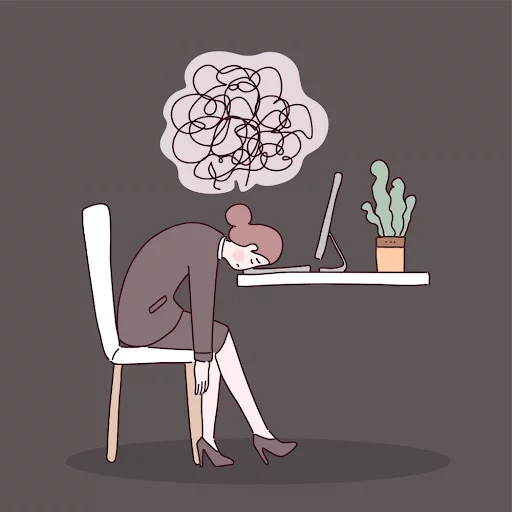
Burnout syndrome: symptoms, prevention and treatment
Burnout is one of the most common and dangerous problems in modern society. The symptom complex, which threatens our physical, mental and emotional health, is not confined to the workplace, although it is most common there.
Our article shows that:
- What can cause burnout;
- Who is most at risk;
- What are the symptoms of burnout;
- What are the stages of burnout;
- How it is diagnosed and treated;
- What are the possibilities of prevention, how coaching can help in prevention and symptom management.

What is burnout and why is it so dangerous?
Burnout, also known as burnout syndrome, is a set of symptoms that can occur as a result of prolonged stress and emotional strain. The process of its development is long and almost everyone affected goes through the same stages. If the symptoms are detected in time, burnout syndrome can be treated and the process reversed. However, this is often not the case, which can lead to complete apathy and, in the worst cases, serious health problems. This can include:
- Development of psychosomatic diseases
- Sleep problems
- Eating disorders
- Behavioural and behavioural problems
- Addiction
Causes of burnout
Burnout is most often associated in the literature with an inadequate work environment. This is why burnout is often referred to as burnout at work.
It is a fact that unfavourable working conditions - such as lack of praise, poor financial conditions, overwork due to too many tasks or second jobs - can cause burnout. But there are also personal factors, such as a tendency to over-idealise work or to over-commit, and other personal characteristics that increase vulnerability.
And it is now clear that not only in the workplace, but virtually anyone can experience signs of burnout at any time.
Who are the most vulnerable?
- Helping professions: e.g. doctors, nurses, social workers, teachers, psychologists, etc. They are under constant emotional strain and find it particularly difficult to set boundaries;
- People in management positions, entrepreneurs: often experience constant stress and performance pressure to get ahead;
- People who are subordinating themselves to some very ambitious goal: the most common goals are career or business building, but extreme amounts of learning, a construction project or even family (e.g. motherhood) can cause personal needs to take a back seat, causing a person to almost lose touch with themselves;
- Expecting too much of themselves: are often characterised by a need for achievement and perfectionism, but the constant extreme expectations cannot be met, which causes enormous frustration
- Seekers of security and harmony: there are those who, by their very nature, cannot identify with the fast pace of today's world, yet try their best to adapt until they are fully absorbed.

Symptoms and stages of burnout
The onset of burnout syndrome can be divided into distinct stages, each with different symptoms. It is important to be aware of these, as early recognition of symptoms can help enormously in prevention and treatment.
The beginnings: over-idealism and enthusiasm
Almost all burnout sufferers show a high level of enthusiasm at first. They often volunteer to take on extra workloads, work with particular creativity, and have a high level of social sensitivity. Accordingly, they receive extra praise and recognition, which further increases their enthusiasm.
Symptoms indicative of the initial stage:
- Extreme enthusiasm, employment
- Too much over-indulgence, the person sees himself as his main working tool
- Private life often takes a back seat
- Towards the end of the phase, enthusiasm can turn into fear and anxiety, and overwork and overstrain can develop
Stage two: frustration with reality
However, extreme work performance cannot be sustained over a long period of time, so the gap between perceptions and actual performance can lead to internal conflict. This can lead to serious frustration.
Symptoms typical of the second stage:
- Work becomes an even more central part of the person's life to prove their excellence
- Neglect of privacy and personal needs occurs
- Despite more time on the job, performance deteriorates, causing further frustration
- Social relations often deteriorate, empathy with colleagues and clients is reduced
Time to decide
It is very important to stress that there is still room for change in the second phase, and for restoring a healthy work-life balance. If the person recognises the problem and works on it consciously, it is still possible to prevent serious burnout at this stage. A healthy relationship with work and a love of work can also develop. Prevention is the subject of a special section in the second part of this article.
Third stage: apathy, development of health problems
Unfortunately, it is often the case that the signs of burnout are not recognised by the person or their environment, and they are simply unable to stop and find the right balance. In this case, the following symptoms occur:
- The person concerned turns inward, becomes indifferent
- His motivation is lost, his work feels monotonous and worthless
- Constant moodiness, hopelessness, loss of hope and feelings of incompetence
- Your work lacks creativity and becomes routine
- Your social relationships, both at work and in your personal life, may become flat and empty
During this phase, the burnout sufferer often exhibits impulsive behaviour, such as becoming impatient with others or changing jobs suddenly. At this stage, burnout is very difficult to manage alone and often requires the involvement of a professional. If this is not done, physical and mental illness can develop.

Managing burnout
If caught early, burnout can be managed through lifestyle and workplace changes, such as:
- By transforming the workplace environment, which requires the involvement of staff
- By consciously restoring the balance between work and leisure
- Regular exercise or meditation
At this point, it is also worth seeking the help of a psychologist or coach who can help you uncover the underlying personal motivational forces and teach you coping techniques. In some cases, a psychiatrist may also need to be involved in the final phase, and may recommend medication, including antidepressants.
Preventing burnout
Fortunately, a positive trend in recent years is that more and more information is being provided and both employers and employees are becoming more aware of burnout. Whereas in the past it was unthinkable to talk about personal difficulties, especially in higher positions, today more and more people are coming forward about their problems. This helps people to recognise early on that they are on the road to burnout.
What can be done at organisational level to prevent burnout?
- Regular assessments and screening of both the work environment and the mental health of employees
- Organising group coaching or various workplace training sessions to reduce stress at work: for example, communication or self-awareness training, relaxation exercises
- Providing the opportunity for psychological counselling, where the employee can talk freely about their inner tensions
What can be done at individual level to prevent burnout?
One of the most important steps in preventing burnout is to be informed. It's the only way to recognise the spiral you're in early enough. Another very important factor is the constant practice of self-reflection and the development of a conscious way of living. However, balancing this on the edge of work, individual and social needs is not easy at all, which is why it may be worth seeking the help of an experienced coach who is well versed in the subject. How can a professional help?
- Identify key intrinsic motivating factors and recognise needs
- Learn coping strategies to help you deal with everyday stress
- Improve work-life balance
- Set the right agenda and follow it
Summary
Burnout syndrome is a burning social problem that, if left untreated, can cause not only lack of motivation but also serious health problems. It is therefore important to understand its phases and symptoms and to take conscious action to prevent and treat it - both at individual and organisational level.
DO YOU HAVE A QUESTION? CONTACT US!
Are you unsure about what form of support could solve your problems? About our coaching services read here for more information, or contact us!

 Designabc
Designabc